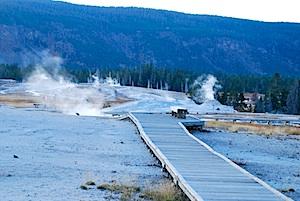Imagine Yellowstone National Park as your own private backyard...and you're not allowed to explore the landscape. That, in essence, is the situation employees of the National Park Service and of concessionaires find themselves in.
"The functions that are closed to the public are also closed to employees," Brad Ross, the park's Lake District ranger, said during a phone call. "So, if you are an employee at Lake, you can’t go hiking the trails. You can’t go up to Mud Volcano and look at the thermal springs and mud pots, things like that.
“The people are kind of limited to functions that you do to maintain. So, any employee or contractor that’s in the park, they are allowed to drive their vehicle to go out to surrounding communities to go to their doctors’ appointments, get groceries, and that kind of stuff. But they’re not allowed to drive around the park," he said.
At the end of the work day, or on their days off, employees are largely restricted to where they live in Yellowstone, the ranger explained.
"If they go for a run, they’re allowed to go for a run from their residence area, but it’s restricted to five miles away," Ranger Ross said. "So they’re not able to go run a trail, but they can run along the Grand Loop Road.”
The ranger, who lives at the park's East Entrance, worked the entrance gate there the day after the parks closed to specifically explain the closure to visitors who had hoped to enter Yellowstone.
"I’m actually pretty impressed with people. I know that anybody that showed up was very upset, because this did impact a lot of people’s vacations," he said. "We had several groups that had flown in from China to come and see the park. We turned away people that were both local and the foreign traveler. The Tennessee traveler. A lot of people.
"I think that at first a lot of people just had confusion on what they could or couldn’t do and whether we could allow them to go in," Ranger Ross went on. "But then, when they understood where things were and what we had going on, then most people were, I don’t know if 'understanding' is the right word for that, but they at least knew that it wasn't something that we had any control over. Very few people put the blame on our individual workers.
"And I think that the kind of things that people were saying is what you’re seeing on most of the news outlets. People are more saying that it’s unfortunate that we’re in this and wished that it could all be resolved and we’d be open.”




Comments
Except that isn't the law or reg. There is no real "problem" it just shows how much people are making things up as they go along. Either the employees shouldn't be there at all, or the park should be open to everyone.
Is your issue, then, the arbitrariness of the distance given by the restriction ("What is magic about five? Why not 4.92 or 8.88?"), or that there is a distance restriction at all ("Either the employees shouldn't be there at all, or the park should be open to everyone")?
It should be all or nothing. It doesn't cost the govt any more or less if someone goes 5 miles or 500 miles. But my issue isn't with the distance at all. It is with the arbitrary application of the "shutdown".